View in other NatureServe Network Field Guides
NatureServe
Montana
Utah
Wyoming
Idaho
Wisconsin
British Columbia
South Carolina
Yukon
California
New York
Douglas Bladderpod - Physaria douglasii
Other Names:
Lesquerella douglasii
State Rank Reason (see State Rank above)
Known from one population in northwest Montana at the edge of Lake Koocanusa. Impacts to the population from ORV use, recreation and erosion of the sandy bluffs are possible, though additional monitoring is needed to determine what impacts if any are occurring.
- Details on Status Ranking and Review
Population Size
Score3 - Vey Small: Generally <2,000 individuals.
Range Extent
Score3 - Local Endemic or Very Small Montana Range: Generally restricted to an area <10,000 sq. miles (equivalent to the combined area of Phillips and Valley Counties) or <6 Sub-basins (4th code watersheds) Range-wide OR limited to one Sub-basin in Montana
Area of Occupancy
Score3 - Very Low: Generally occurring in 3 or fewer Subwatersheds (6th Code HUC’s).
Environmental Specificity
Score2 - High: Species is restricted to a highly specialized and limited habitat and is typically dependent upon unaltered, high-quality habitat (C Values of 8-10).
Trends
ScoreNA - Rank factor not assessed.
CommentMonitoring data are lacking to determine actual trends, though it seems likely that minor declines have occurred due to ORV use, erosion and development.
Threats
Score2 - High: 31-70% of the populations are being negatively impacted or are likely to be impacted by one or more activities or agents, which are expected to result in decreased populations and/or habitat quality and/or quantity.
Intrinsic Vulnerability
Score1 - Moderate Vulnerability: Specific biological attributes, unusual life history characteristics or limited reproductive potential makes the species susceptible to extirpation from stochastic events or other adverse impacts to its habitat and slow to recover.
Raw Conservation Status Score
Score
14 total points scored out of a possible 16 (Rarity factors and threats only).
General Description
Stems erect, 10–30 cm from a simple caudex. Basal leaves 2–9 cm long; the blade oblanceolate to obovate with entire to weakly dentate margins. Stem leaves numerous, narrowly oblanceolate, entire. Vestiture of 4- to 6-rayed sessile hairs. Petals 6–9 mm long. Fruit globose, inflated, 3–4 mm high style 3–4 mm long; seeds 2 to 4 per locule; pedicels ascending, straight to sigmoid, 6–20 mm long (
Lesica et al. 2012. Manual of Montana Vascular Plants. BRIT Press. Fort Worth, TX).
Species Range
Montana Range
Range Descriptions
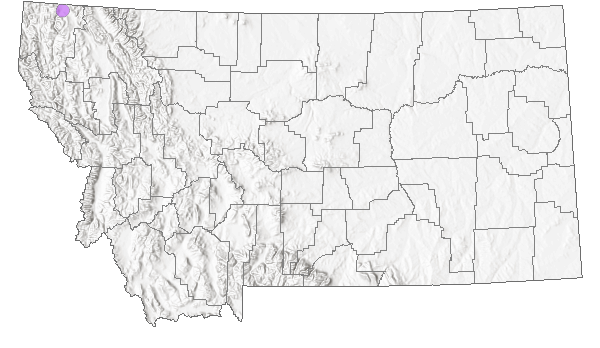
 Native
Native
Range Comments
BC, MT south to WA, OR. Known only from Lincoln County (Lesica et al. 2012. Manual of Montana Vascular Plants. BRIT Press. Fort Worth, TX).
Observations in Montana Natural Heritage Program Database
Number of Observations: 9
(Click on the following maps and charts to see full sized version)
Map Help and Descriptions
Relative Density
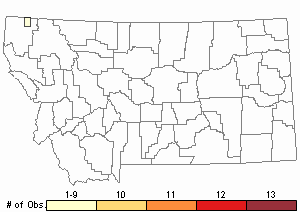
Recency
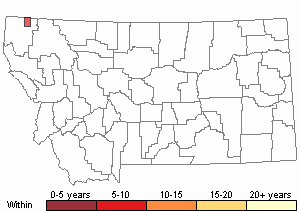
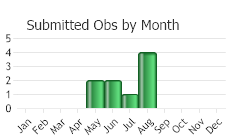
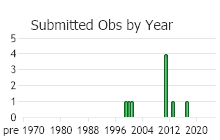
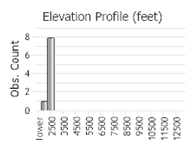 (Observations spanning multiple months or years are excluded from time charts)
(Observations spanning multiple months or years are excluded from time charts)
Habitat
Sandy soils in open, ponderosa pine woodlands
Ecological Systems Associated with this Species
Threats or Limiting Factors
STATE THREAT SCORE REASON
Montana's entire population of Douglas Bladderpod is clustered on a single area of fine sands near a reservoir shoreline. Reported threats to Montana's population of Douglas Bladderpod indicate that off-highway vehicle (OHV) recreation and persistent erosion by lake water has potential to severely impact the population considering its concentrated distribution and sandy substrate (MTNHP Threat Assessment 2021).
References
- Literature Cited AboveLegend:
 View Online Publication
View Online Publication Lesica, P., M.T. Lavin, and P.F. Stickney. 2012. Manual of Montana Vascular Plants. Fort Worth, TX: BRIT Press. viii + 771 p.
Lesica, P., M.T. Lavin, and P.F. Stickney. 2012. Manual of Montana Vascular Plants. Fort Worth, TX: BRIT Press. viii + 771 p.
- Additional ReferencesLegend:
 View Online Publication
View Online Publication
Do you know of a citation we're missing? Al-Shehbaz, I. A. and S. L. O'Kane. 2002. Lesquerella is united with Physaria (Brassicaceae). Novon 12:319-329.
Al-Shehbaz, I. A. and S. L. O'Kane. 2002. Lesquerella is united with Physaria (Brassicaceae). Novon 12:319-329. Lesica, P., M.T. Lavin, and P.F. Stickney. 2022. Manual of Montana Vascular Plants, Second Edition. Fort Worth, TX: BRIT Press. viii + 779 p.
Lesica, P., M.T. Lavin, and P.F. Stickney. 2022. Manual of Montana Vascular Plants, Second Edition. Fort Worth, TX: BRIT Press. viii + 779 p.
- Web Search Engines for Articles on "Douglas Bladderpod"





